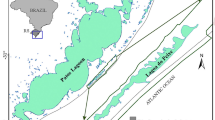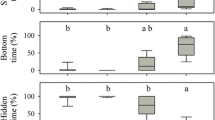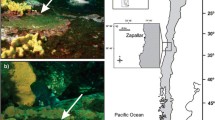Abstract
Astacus leptodactylus is a widespread European crayfish species with both native and invasive populations. However, in spite of its wide distribution, studies regarding its activity seem to be lacking. Thus, our goal was to study its preference towards shelters built from natural and artificial materials and follow its activities throughout the day in order to understand its diel activity patterns. We analyzed the video recordings of diel activities for 20 individuals to find out more about this species routine in a captive environment. Every specimen spent 22 hours in an arena with 4 different kinds of shelters provided (stone, wood, PVC pipe, vegetation). We investigated time spent in every shelter and different activity patterns throughout the analysis period. A preference for stone and wooden shelters was clearly expressed by all the individuals, independent of sex and size. Most of the activity was concentrated in close proximity to the provided shelters. Individuals exhibited both daytime and nighttime activity, with the latter being more intense, although, specimens spent almost 85% of the entire time inside shelters. Crayfish used all available shelters during our trials, proving a wide flexibility of the species towards shelter type, but the frequency of visits and time spent inside certain type of shelter varied significantly. Our study brings novel information regarding narrow-clawed crayfish shelter preference and activity in the proximity of the shelters, highlighting the importance of natural refuges in its daily routine.
Similar content being viewed by others
References
Aquiloni L., Ilhéu M. & Gherardi F. 2005. Habitat use and dispersal of the invasive crayfish Procambarus clarkii in ephemeral water bodies of Portugal. Mar Freshw. Behav. Physiol. 38(4): 225–236. DOI: 10.1080/10236240500310195
Aquiloni L., Tricarico E. & Gherardi F. 2010. Crayfish in Italy: distribution, threats and management. Int. Aquat. Res. 2(1): 1–14.
Barbaresi S. & Gherardi F. 2001. Daily activity in the white-clawed crayfish, Austropotamobius pallipes: a comparison between field and laboratory studies. J. Nat. Hist. 35(12): 1861–1871. DOI: 10.1080/00222930110098111
Barbaresi S., Santini G., Tricarico E. & Gherardi, F. 2004. Ranging behavior of the invasive crayfish Procambarus clarkii (Girard). J. Nat. Hist. 38(22): 2821–2832. DOI: 10.1080/00222930410001663308
Belanger R.M. & Moore P.A. 2006. The use of the major chelae by reproductive male crayfish (Orconectes rusticus) for discrimination of female odours. Behaviour 143(6): 713–731. DOI: 10.1163/156853906777791342
Benvenuto C., Gherardi F. & Ilhéu M. 2008. Microhabitat use by the white-clawed crayfish in a Tuscan stream. J. Nat. Hist. 42(1-2): 21–33. DOI: 10.1080/00222930701799090
Bergman D.A. & Moore P.A. 2003. Field observations of intraspe-cific agonistic behaviour of two crayfish species, Orconectes rusticus and Orconectes virilis, in different habitats. Biol. Bull. 205(1): 26–35. DOI: 10.2307/1543442
Bohl E. 1997. An isolated population of the white-clawed crayfish Austropotamobius pallipes) in the Principality of Liechtenstein. Bull. Fr. Pęche Piscic. 347: 701–712. DOI: 10.1051/kmae/1997052
Briede I. 2011. Crayfish in Latvia. Acta Biol. Univ. Daugavp. 11(1): 83–87.
Bubb D.H., Thorn T.J. & Lucas M.C. 2004. Movement and dispersal of the invasive signal crayfish Pacifastacus leniusculus in upland rivers. Freshwater Biol. 49(3): 357–368. DOI: 10.1111/j.1365-2426.2003.01178.x
Bubb D.H., Thorn T.J. & Lucas M.C. 2006. Movement, dispersal and refuge use of co-occurring introduced and native crayfish. Freshwater Biol. 51: 1359–1368. DOI: 10.1111/j. 1365-2427.2006.01578.x
Bubb D.H., Thorn T.J. & Lucas M.C. 2008. Spatial ecology of the white-clawed crayfish in an upland stream and implications for the conservation of this endangered species. Aquatic Conserv: Mar. Freshwater Ecosyst. 18(5): 647–657. DOI: 10.1002/aqc.862
Buřič M., Kouba A. & Kozák P. 2009a. Spring mating period in Orconectes limosus: The reason for movement! Aquat. Sci. 71(4): 473–477. DOI: 10.1007/s00027-009-0102-6
Buřič M., Kozák P. & Kouba A. 2009b. Movement patterns and ranging behavior of the invasive spiny-cheek crayfish in a small reservoir tributary. Fundam. Appl. Limnol. 174(4): 329–337. DOI: 10.1127/1863-9135/2009/0174-0329
Byrne C.F., Lynch J.M. & Bracken J.J. 1999. A sampling strategy for stream populations of white-clawed crayfish, Austropotamobius pallipes (Lereboullet) (Crustacea, Astacidae). Biol. Environ. 99B(2): 89–94.
Capelli G.M. & Hamilton P.A. 1984. Effects of food and shelter on aggressive activity in the crayfish Orconectes rusticus (Girard). J. Crust. Biol. 4(2): 252–260. DOI: 10.2307/1548022
Capelli G.M. & Magnuson J.J. 1983. Morphoedaphic and biogeo-graphic analysis of crayfish distribution in northern Wisconsin. J. Crust. Biol. 3(4): 548–564. DOI: 10.1163/193724083 X00210
Chucholl C., Stich H.B. & Maier G. 2008. Aggressive interactions and competition for shelter between a recently introduced and an established invasive crayfish: Orconectes immunis vs. O. limosus. Fundam. Appl. Limnol. 172(1): 27–36. DOI: 10.1127/1863-9135/2008/0172-0027
Clark J.M., Kershner M.W. & Holomuzki J.R. 2008. Grain size and sorting effects on size dependent responses by lotic crayfish to high flows. Hydrobiologia 610(1): 55–66. DOI: 10.1007/sl0750-008-9422-0
Davis K.M. & Huber R. 2007. Activity patterns, behavioural repertoires, and agonistic interactions of crayfish: A non-manipulative field study. Behaviour 144(2): 229–247. DOI: 10.1163/156853907779947300
Derraik J.G.B. 2012. The pollution of the marine environment by plastic debris: a review. Mar. Pollut. Bull. 44(9): 842–852. DOI: 10.1016/S0025-326X(02)00220-5
Edmonds N.J., Riley W.D., Maxwell D.L. 2011. Predation by Pacifastacus leniusculus on the intra-gravel embryos and emerging fry of Salmo salar. Fisheries Manag. Ecol. 18(6): 521–524. DOI: 10.1111/j.1365-2400.2011.00797.x
Englund G. & Krupa J.J. 2000. Habitat use by crayfish in stream pools: influence of predators, depth and body size. Freshwater Biol. 43(1): 75–83. DOI: 10.1046/j.1365-2427.2000.00524.x
Fero K.C. & Moore P.A. 2008, Social spacing of crayfish in natural habitats: what role does dominance play? Behav. Ecol. Sociobiol. 62(7): 1119–1125. DOI: 10.1007/s00265-007-0540-x
Fero K.C. & Moore P.A. 2014. Shelter availability influences social behavior and habitat choice in crayfish, Orconectes virais. Behaviour 151(1): 103–123. DOI: 10.1163/1568539X-00003125
Fidalgo M.L, Carvalho A.V. & Santos P. 2001. Population dynamics of the red swamp crayfish, Procambarus clarkii (Girard, 1852) from the Aveiro Region, Portugal (De-capoda, Cambaridae). Crustaceana 74(4): 369–375. DOI: 10.1163/156854001300104453
Franke R. & Hoerstgen-Schwark G. 2015. Lunar-rhythmic molting in laboratory populations of the noble crayfish Astacus astacus (Crustacea, Astacidea): An experimental analysis. PloS One 8(7): e6865. DOI: 10.1371/journal.pone.0068653
Garvey J.E., Stein R.A. & Thomas H.M. 1994. Assessing how fish predation and interspecific prey competition influence a crayfish assemblage. Ecology 75(2): 532–547. DOI: 10.2307/1939556
Gherardi F., Barbaresi S. & Salvi G. 2000. Spatial and temporal patterns in the movement of the red swamp crayfish, Procambarus clarkii, an invasive crayfish. Aquat. Sci. 62(2): 179–193. DOI: 10.1007/PL00001330
Gherardi F., Tricarico E. & Ilhéu M. 2002. Movement patterns of the invasive crayfish, Procambarus clarkii, in a temporary stream of southern Portugal. Ethology, Ecology & Evolution 14(3): 183–197. DOI: 10.1080/08927014.2002.9522739
Ghia D., Fea G., Spairania M., Berninia F. & Nardi P.A. 2009. Movement behaviour and shelter choice of the native crayfish Austropotamobius pallipes complex: survey on a population in a semi-natural pond in Northern Italy. Mar Freshw. Behav. Physiol. 42(3): 167–185. DOI: 10.1080/10236240902916680
Griffiths S.W., Collen P. & Armstrong, J.D. 2004. Competition for shelter among over-wintering signal crayfish and juvenile Atlantic salmon. J. Fish Biol. 65(2): 436–447. DOI: 10.1111/j.0022-1112.2004.00460.x
Guan R.Z. 1994. Burrowing behaviour of signal crayfish, Pacifas-tacus leniusculus (Dana), in the River Great Ouse, England. Freshwater Forum 4(3): 155–168.
Hirsch P., Burkhardt-Holm P., Töpfer I. & Fischer P. 2016. Movement patterns and shelter choice of spiny-cheek crayfish ( Orconectes limosus) in a large lake’s littoral zone. Aquat. Invasions 11(1): 55–65. DOI: 10.3391/ai.2016.11.1.06
Hogger J.B. 1988. Ecology, population biology and behaviour, pp. 114–144. In: Holdich D.M. & Lowery R.S. (eds), Freshwater Crayfish: Biology, Management and Exploitation, Croom Helm, London, 498 pp. ISBN: 088192105X
Holdich D.M. 2002. Distribution of crayfish in Europe and some adjoining countries. Bull. Fr. Pęche Piscic. 367: 611–650. DOI: 10.1051/kmae:2002055
Holdich D.M., Reynolds J.D., Souty-Grosset C. & Sibley P.J. 2009. A review of the ever increasing threat to European crayfish from the non-indigenous crayfish species. Knowl. Managt. Aquatic Ecosyst. 394-395: 11. DOI: 10.1051/kmae/2009025
Hudina S., Galić N., Roessink I. & Hock K. 2011. Competitive interactions between co-occurring invaders: identifying asymmetries between two invasive crayfish species. Biol. Invasions 13(8): 1791–1803. DOI: 10.1007/sl0530-010-9933-2
Hudina S., Hock K., Radovic A., Klobucar G., Petkovic J., Jelic M. & Maguire I. 2016. Species-specific differences in dynamics of agonistic interactions may contribute to the competitive advantage of the invasive signal crayfish (Pacifastacus leniusculus) over the native narrow-clawed crayfish (Astacus leptodactylus). Mar. Freshw. Behav. Physiol. 49(3): 147–157. DOI: 10.1080/10236244.2016.1146448
Hudina S., Maguire I. & Klobucar G.I.V. 2008. Spatial dynamics of the noble crayfish (Astacus astacus, L.) in the Paklenica National Park. Knowl. Managt. Aquatic Ecosyst. 388: 01. DOI: 10.1051/kmae:2008001
Huner J.V. & Barr J.E. 1991. Red Swamp Crayfish: Biology and Exploitation. 3. ed. Lousiana Sea Grant College Program. Lousiana State University, Baton Rouge, 128 pp.
Kouba A., Petrusek A. & Kozák P. 2014. Continental-wide distribution of crayfish species in Europe: update and maps. Knowl. Managt. Aquatic Ecosyst 413: 05. DOI: 10.1051/kmae/2014007
Kouba A., Tíkal J., Císař P., Vesely L., Fořt M., Příborsky J., Patoka J. & Buřič M. 2016. The significance of droughts for hyporheic dwellers: evidence from freshwater crayfish. Sci. Rep. 6: 26569. DOI: 10.1038/srep26569.
Kozák P., Gallardo J.M. & García J.C.E. 2009. Light preferences of red swamp crayfish (Procambarus clarkii). Hydrobiologia 636(1): 499–503. DOI: 10.1007/sl0750-009-9937-z
Loughman Z.J., Skalican K.T. & Taylor N.D. 2013. Habitat selection and movement of Gambarus chasmodactylus (Decapoda: Cambaridae) assessed via radio telemetry. Freshwater Sci. 32(4): 1288–1297. DOI: 10.1899/12-166.1
Lozán J.L. 2000. On the threat to the European crayfish: A contribution with the study of the activity behaviour of four crayfish species (Decapoda: Astacidae). Limnologica 30(2): 156–166. DOI: 10.1016/S0075-9511(00)80010-9
Lynas J., Storey A.W. & Knott B. 2007. Aggressive interactions between three species of freshwater crayfish of the genus Cherax (Decapoda: Parastacidae). Mar. Freshw. Behav. Physiol. 40(2): 105–116. DOI: 10.1080/10236240701245539
Maguire I., Jelić M. & Klobučar G. 2011. Update on the distribution of freshwater crayfish in Croatia. Knowl. Managt. Aquatic Ecosyst 401: 31. DOI: 10.1051/kmae/2011051
Martin A.L. & Moore P.A. 2008. The influence of dominance on shelter preference and eviction rates in the crayfish, Orconectes rusticus. Ethology 114(4): 175–188. DOI: 10.1111/j.1439-0310.2008.01473.x
Maude S.H. & Williams D.D. 1983. Behavior of crayfish in water currents: hydrodynamics of eight species with reference to their distribution patterns in southern Ontario. Can. J. Fish. Aquat. Sci. 40(1): 68–77. DOI: 10.1139/f83-010
McClain W.R. & Romaire R. P. 2007. Procambarid crawfish: life history and biology. Southern Regional Aquaculture Center, Publ. no. 2403, 6 pp.
Moore P.A. & Bergmann D.A. 2005. The smell of successand failure: The role of intrinsic and extrinsic chemical signals on the social behaviour of crayfish. Integr. Comp. Biol. 45(4): 650–657. DOI: 10.1093/icb/45.4.650.
Musil M., Buřič M., Policar T., Kouba A. & Kozák P. 2010. Comparison of day and night activity between noble (Astacus astacus) and spiny-cheek crayfish (Orconectes limosus). Freshwater Crayfish 17: 189–193.
Nakata K. & Goshima S. 2003. Competition for shelter ofpre-ferred sizes between the native crayfi sh species Cambaroides japonicus and the alien crayfi sh species Pacifastacus leniusculus in Japan in relation to prior residence, sex difference and body size. J. Crustacean Biol. 23(4): 897–907. DOI: 10.1651/C-2411
Naura M. & Robinson M. 1998. Principles of using River Habitat Survey to predict the distribution of acquatic species: an example applied to the native white-clawed crayfish Austropotamobius pallipes. Aquatic Conserv: Mar. Fresh-wat. Ecosyst. 8(4): 515–527. DOI: 10.1002/(SICI)1099-07 55(199807/08)8:4%3C515::AID-AQC261%3E3.0.CO;%202-J
Panksepp J.B. & Huber R. 2004. Ethological analyses of crayfish behavior: a new invertebrate system for measuring the rewarding properties of psychostimulants. Behav. Brain Res. 153(1): 171–180. DOI: 10.1016/j.bbr.2003.11.014
Párvulescu L., Palos C. & Molnar P. 2009. First record of the spiny-cheek crayfish Orconectes limosus (Rafinesque, 1817) (Crustacea: Decapoda: Cambaridae) in Romania. North-West. J. Zool. 5(2): 424–428.
Párvulescu L. & Zaharia C. 2014. Distribution and ecological preferences of noble crayfish in the Carpathian Danube basin: biogeographical insights into the species history. Hydrobiologia 726(1): 53–63. DOI: 10.1007/sl0750-013-1751-y
Pârvulescu L., Zaharia C., Groza M.L, Csillik O., Satmari A. & Drâgut L. 2016. Flash-flood potential: a proxy for crayfish habitat stability. Ecohydrology 9: 1507–1516. DOI: 10.1002/eco.l744
Ranta E. & Lindstrom K. 1993. Body size and shelter possession in mature signal crayfish, Pacifastacus leniusculus. Ann. Zool. Fenn. 30(2): 125–132.
Renz M. & Breithaupt T. 2000. Habitat use of the crayfish Austropotamobius torrentium in small brooks and in Lake Constance, Southern Germany. Bull. Fr. Pęche Piscic. 356: 139–154. DOI: 10.1051/kmae:2000008
Robinson C.A., Thorn T.J. & Lucas M.C. 2000. Ranging behaviour of a large freshwater invertebrate, the white-clawed crayfish Austropotamobius pallipes. Freshwater Biol. 44(3): 509–521. DOI: 10.1046/j.1365-2427.2000.00603.x
Simić V., Petrović A., Rajković M. & Paunović M. 2008. Crayfish of Serbia and Montenegro - the population status and the level of endangerment. Crustaceana 81(10): 1153–1176. DOI: 10.1163/156854008X374496
Statzner B., Fievet E., Champagne J.Y., Morel R. & Herouin E. 2000. Crayfish as geomorphic agents and ecosystem engineers: biological behavior affects sand and gravel erosion in experimental streams. Limnol. Oceanogr. 45(5): 1030–1040. DOI: 10.4319/10.2000.45.5.1030
Streissl F. & Hödl W. 2002. Habitat and shelter requirements of the stone crayfish, Austropotamobius torrentium Schrank. Hydrobiologia 477(1): 195–199. DOI: 10.1023/A:102109430 9738
Stucki T.P. 2002. Differences in live history of native and introduced crayfish species in Switzerland. Freshwater Crayfish 13: 463–476.
Thomas J.R., James J., Newman R.C., Riley W.D., Griffiths S.W. & Cable J. 2015. The impact of streetlights on an aquatic invasive species: Artificial light at night alters signal crayfish behavior. Appl. Anim. Behav. Sci. 176: 143–149. DOI: 10.1016/j.applanim.2015.11.020
Troschel H.J. 1997. Distribution and ecology of Austropotamobius pallipes in Germany. Bull. Fr. Pęche Piscic. 347: 639–647. DOI: 10.1051/kmae/1997049
Tulonen J., Erkamo E., Jussila J. & Mannonen A. 2008. Shelter and depth use of adult noble crayfish (Astacus astacus (L.)) and signal crayfish (Pacifastacus leniusculus (Dana)) in the presence of a predator. Freshwater Crayfish 16: 93–96.
Viau V.E. & Rodriguez E.M. 2010. Substrate selection and effect of different substrates on survival and growth of juveniles of the freshwater crayfish Cherax quadricarinatus (von Martens 1868) (Decapoda, Parastacidae). Aquacult. Int. 18(5): 717–724. DOI: 10.1007/sl0499-009-9292-0
Vlach P., Fischer D. & Hulec L. 2009. Microhabitat preferences of the stone crayfish Austropotamobius torrentium (Schrank, 1803). Knowl. Managt. Aquatic Ecosyst. 394-395: 15. DOI: 10.1051/kmae/2010008
Warfe D.M. & Barmuta L.A. 2006. Habitat structural complexity mediates food web dynamics in a freshwater macrophyte community. Oecologia 150(1): 141–154. DOI: 10.1007/s00442-006-0505-1
Webb M. & Richardson A. 2004. A radio telemetry study of movement in the giant Tasmanian freshwater crayfish, Astacopsis gouldi. Freshwater Crayfish 14: 197–204.
Westman K. 1985. Effects of habitat modification on freshwater crayfish, pp. 245–255. In: Alabaster J.S. (ed.), Habitat Modifications and Freshwater Fisheries, European Inland Fisheries Advisory Commission, Butterworths, London, 287 pp. ISBN: 0-407-00418-1
Wutz S. & Geist J. 2013. Sex- and size-specific migration patterns and habitat preferences of invasive signal crayfish (Pacifastacus leniusculus Dana). Limnologica 43(2): 59–66. DOI: 10.1016/j.limno.2012.02.002
Acknowledgements
We wish to thank Prof. Dr. Ivana Maguire for providing feedback and useful comments for our manuscript. We also want to thank the anonymous reviewers for their insightful and constructive comments. Additional thanks go to Dr. Hajnalka Sas-Kovács for English language proofreading of the manuscript and Dr. Sebastian Pintea for the practical advices on statistical analysis.
Author information
Authors and Affiliations
Corresponding author
Rights and permissions
About this article
Cite this article
Groza, M.I., Pop-Vancia, V. & Mireşan, V. Diel activity and use of multiple artificially constructed shelters in Astacus leptodactylus (Decapoda: Astacidae). Biologia 71, 1369–1379 (2016). https://doi.org/10.1515/biolog-2016-0167
Received:
Accepted:
Published:
Issue Date:
DOI: https://doi.org/10.1515/biolog-2016-0167




